A collection of conversations with a diverse range of local and regional creatives
Library Conversations for SGABF2020
We examined the systems that support art book making and independent art book publishing in Singapore and the region.
A Closer Look for SGABF2019
We gathered perspectives on our zine and art book culture, and discuss the possibilities of self-publishing today.
21 Creatives for SGABF2018
We sat down with 21 creatives of various disciplines to learn about their practice and asked each of them to fill up a blank page in a notebook.
Queer Reads Library and Queer Zine Fest
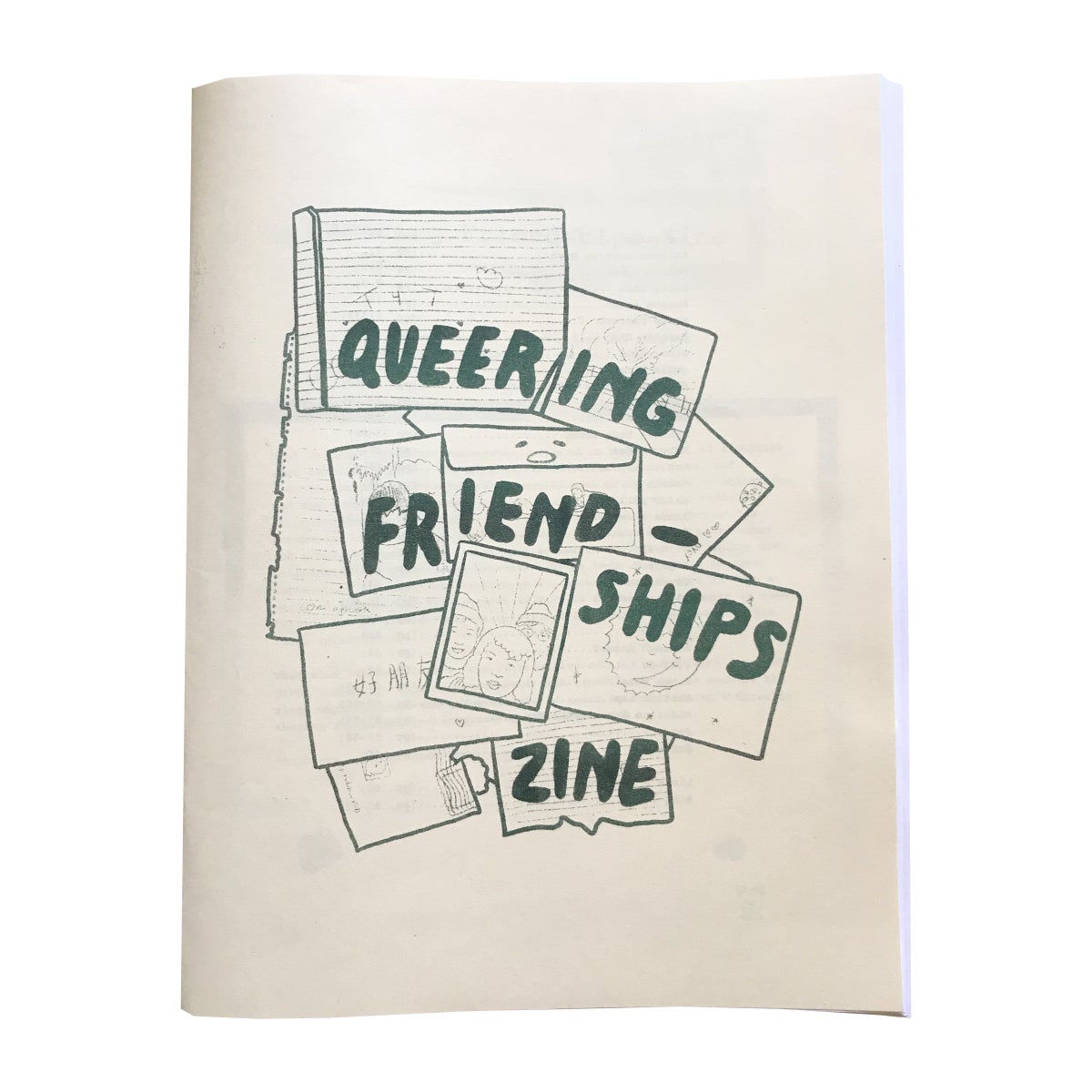 Photo Credit: Queering Friendships by Mixed Rice Zines
Photo Credit: Queering Friendships by Mixed Rice ZinesOBJECT LESSONS SPACE (C): Hi Queer Reads Library and Queer Zinefest! Our first question for both teams relates to the zines that were selected for our conversation. It was clear that the zines that were chosen are near and dear to the hearts of both teams. Could you both tell us a little bit as to how you picked these zines out, and how your own personal connection with zines began?
Queer Reads Library (QRL): When Beatrix and Kaitlin were co-founding QRL, Beatrix connected the library to Unity Press from Oakland, California. Through Unity, we were introduced to the Taiwanese-American artist J. Wu who creates compilation zines under the title Mixed Rice Zines. Kaitlin connected with J over email in 2018 during QRL’s first pop-up, and one year later they met IRL in Taipei. Kaitlin and J felt instant friend chemistry, and J started brainstorming their next collaborative zine with the theme Queering Friendships, on finding love and intimacy outside heteronormative/romantic norms. The zine features over thirty contributors, mainly queer/trans and Asian identified. It feels fitting that this zine about friendship is laced through with personal connections: the mutual support between Beatrix and Jeffrey, Jeffrey and J, J and Kaitlin, and all the contributors who sent in their photos of friends, friend-love letters, poems, drawings and texts.
As for the back issues of Horizons, the publication is named after a support hotline that is currently led by Reggie Ho (also founder of LGBTQI+ nonprofit Pink Alliance). Founded in February 1992, Horizons hotline is one of Hong Kong’s oldest queer support organisations, and has three call lines in Cantonese and English. Ho joined as a volunteer in 1998. Their publication Horizons is described as “Hong Kong’s comprehensive resource on lesbian & gay counselling since 1992". It contains bi-lingual coverage of queer meet-up spots, letters to the editor, event/party/parade listings, and resource lists. The design is eye-catching and playful, with collage elements and bright spot colors (lime green, egg yolk yellow) that celebrate a queer sensibility alongside important information.

Queer Zine Fest (QZF): We picked zines that are by Queer zinesters in Singapore! There are so many good local LGBTQIA+ creators making punk zines, chapbooks, art zines, political zines… (and you can find lots of them through us!) but we finally managed to narrow it down to two that we're personally enjoying a lot right now. Aki's zine is so comfortingly confessional and warm. Especially now that lots of us Queers are disconnected from our LGBTQIA+ families or stuck with less-accepting housemates, Dysphoria Diarrhoea is a knowing smile and an empathetic corner to sprawl out in. As for Esther’s currently untitled zine, her expressive linework and text read as a heartfelt memento to those who are still figuring out who they are. A stream of consciousness approach to crushes and “queer existential crises”– like a letter to a younger self that someone else had penned.

Image courtesy of Esther (she/her)
QZF: The team all came to zines at different points in our lives and for different reasons, but we're all united in our belief that zines can be a super powerful resource and healing force for Queer people! Zines are so radical as a totally uncensored, personalised medium in a country where everything is heavily censored and commercialised.
OLS: Zines have always been an alternative and important source of information, and often function as community noticeboards, disseminating information and educating readers. Horizons was one such resource, and was incredibly important for queer community in the 90s. Could you tell us about the significance of having these back issues in your collection, especially considering their historical significance.

Photo Credit: Horizons issue 32, 1998
QRL: QRL has been incredibly privileged to befriend longstanding members of the LGBTQ+ community in Hong Kong, including activist Connie Chan and designer Po Hung. It is through these connections that we are able to access printed matter produced by the HK queer community in the 1990s. In fact, Po Hung— the Horizons newsletter designer— donated these back issues to our library. Having queer vintage titles in our collection reminds us that the work we’re doing as a library and community space is a continuation of the work that’s been done by queer folks before us. Since the founding of QRL in 2018, we’ve had the opportunity to foster intergenerational connections with queer folks of all ages, and we cherish these connections deeply. For example, back in May 2019, we had the chance to meet with an intergenerational group of queer folks for our Queer Lexicon workshop to discuss the various terms used by our community throughout the years in HK.
OLS: Something that struck me whilst looking through the zines that your team picked out was that they both use the zine, illustrations and emotive text to work through complex feelings. As organisers and creatives yourselves, has it been important for your team to work alongside and collaboratively with zine-makers who lean into and embrace the zine’s material and affective quality?


Photo Credits: Sayoni x QZF at The Moon, 2019
QZF: Absolutely! Although we suppose that pretty much all zinesters embrace the zine’s intuitiveness and emotion – you must really feel for something to get down and create it all on your own. There’s a certain immediacy to the medium, a certain urgency in the way we curl together and produce small quantities of things very close to our hearts, and I think that kind of blurry-eyed euphoria is at the heart of what QZF does. The zinesters we’ve met through its two year lifespan have really shaped the way we see zines as a whole, and I think each and every person we’ve worked with has also left a deep, wonderful footprint on our own paths as artists, organisers and human beings.
OLS: The importance of safe and affirming queer spaces cannot be over-emphasised, and this is something that both Queer Reads Library and Queer Zine Fest have worked towards through the establishment of physical presence in terms of a library and a festival respectively. Having said that, both initiatives take a slightly more transient approach with regard to a permanent venue.
Could both teams speak a little bit more as to whether the format of the zine (in terms of DIY/punk culture or ease of distribution) influenced this peripatetic approach, and how this fluidity has shaped your understanding of what or where a safe space can be.

QRL at Booked Art Book Fair Hong Kong 2019, Image courtesy of QRL
QRL: The DIY nature of zinemaking and self-publishing frees us to imagine a library beyond a set location. In particular, the challenges of nurturing and building queer-positive and intersectional spaces in Hong Kong is amplified by high rental/operation costs and the acceleration of capitalism. We combat the notion that the library must have a fixed location by celebrating our malleability to pop-up wherever we may be, if that happens to be Vancouver, Taipei, or Singapore. By curating selections for specific audiences, the library is responsive to its various audiences across different geographies. A safer space looks like where we can add to and be part of existing conversations and communities, rather than just parachute in. We aim to listen and learn, and are grateful for the privilege to be welcomed into people’s homes, DIY spaces, and book fairs.
QRL at HK Queer Literary & Cultural Festival 2019, Image courtesy of QRL
QZF: Yeah – a zine itself is so definitely a safe space. A portable brave space! A space just for you, which you can share or not share as you like. Nobody can come into your zine! Nobody can intrude on your space. That’s one of the reasons it’s so powerful as a space/tool for Queer people, especially in Singapore where there really aren’t a lot of physical spaces you can be loud and Queer and brutally feel things.
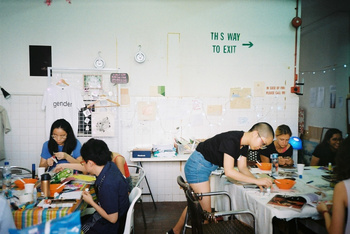
QUEERSTMAS at soft/WALL/studs, 2018
We didn’t want a permanent venue because we like the idea of highlighting a new LGBTQIA+ friendly space every time we bring people together. Queer spaces in Singapore are few and far between – we’re mostly relegated to the nightlife. It’s been really exciting to encounter all these places that exist right under our noses that are actually really welcoming and loving. We worked with Camp Kilo in 2018, and The Moon, BUNKERBUNKER!! and soft/WALL/studs in 2019. All of these are spaces that are accessible to under-eighteens and people who may not want to be in a space where there’s dancing and loud music and drinking.
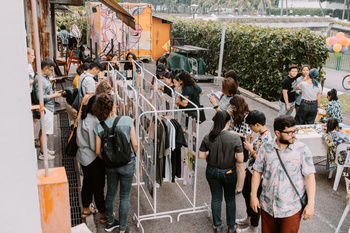
Queer ZineFest SG at Camp Kilo Charcoal Club, 2018
That approach has been kind of altered by COVID-19, because physical spaces are no longer an option for a lot of people. These few months have shifted our focus to the ways online planes can become brave spaces too. It’s not a new phenomenon – the Internet has always been an alcove for young Queer people! But I guess we’re learning how as organisations, we can be involved in building that safety net without intruding on the webs people have already built for themselves. For us, that looked like creating a Discord channel for LGBTQIA+ people in Singapore, and running Pajama Parties on Instagram Live during the CircuitBreaker.
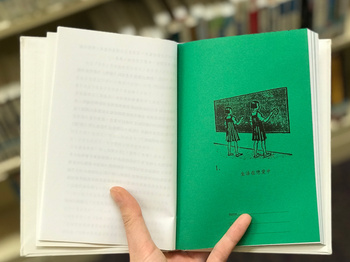
On Love by Edward Lam, published by ChenMiJi (from QRL’s zine collection)
QRL: When we think of zines, we think: grassroots, DIY, and free. This attitude towards zine-making is definitely present in our approach to showcasing and curating our collection. When we first started, our collection consisted of zines from our personal collections and publications that were sent to us from artists we reached out to online. Since then, we’ve added to our collection through picking up zines at different fairs, purchasing from artists we admire directly, or accepting gifts from friends who thought of QRL in their travels. The pop-up style of our library has also allowed us to present our titles in forms ranging from a table display to a makeshift bookshelf using milk crates.
![]()
daikon Issue 3: Queer/Trans (from QRL’s zine collection)
Not having a physical location for QRL is both limiting and freeing. While we have the freedom to show-up in whatever space will have us, we also recognize that not having a space is due to the limitation of resources for many grassroots collections like ours. At the end of the day though, we always say that it’s not about the books themselves but the connections we make. What gives QRL it’s power is the relationships we build with our readers, fellow artists, and other queer folks worldwide.

QUEERSTMAS at soft/WALL/studs, 2018
We didn’t want a permanent venue because we like the idea of highlighting a new LGBTQIA+ friendly space every time we bring people together. Queer spaces in Singapore are few and far between – we’re mostly relegated to the nightlife. It’s been really exciting to encounter all these places that exist right under our noses that are actually really welcoming and loving. We worked with Camp Kilo in 2018, and The Moon, BUNKERBUNKER!! and soft/WALL/studs in 2019. All of these are spaces that are accessible to under-eighteens and people who may not want to be in a space where there’s dancing and loud music and drinking.

Queer ZineFest SG at Camp Kilo Charcoal Club, 2018
That approach has been kind of altered by COVID-19, because physical spaces are no longer an option for a lot of people. These few months have shifted our focus to the ways online planes can become brave spaces too. It’s not a new phenomenon – the Internet has always been an alcove for young Queer people! But I guess we’re learning how as organisations, we can be involved in building that safety net without intruding on the webs people have already built for themselves. For us, that looked like creating a Discord channel for LGBTQIA+ people in Singapore, and running Pajama Parties on Instagram Live during the CircuitBreaker.
OLS: Zine-making culture is incredibly multifaceted, and there’s a real spectrum when we begin thinking about what a zine can be or look like. As a result of this incredible diversity, some institutional archives and libraries have found it difficult to catalogue, collect or showcase zines.
Tell us about your team’s experiences with regard to collecting or showcasing zines: what has been rewarding, but what have you found limiting? How can we begin to expand our curatorial frameworks or archival vocabularies to embrace this range?

On Love by Edward Lam, published by ChenMiJi (from QRL’s zine collection)
QRL: When we think of zines, we think: grassroots, DIY, and free. This attitude towards zine-making is definitely present in our approach to showcasing and curating our collection. When we first started, our collection consisted of zines from our personal collections and publications that were sent to us from artists we reached out to online. Since then, we’ve added to our collection through picking up zines at different fairs, purchasing from artists we admire directly, or accepting gifts from friends who thought of QRL in their travels. The pop-up style of our library has also allowed us to present our titles in forms ranging from a table display to a makeshift bookshelf using milk crates.
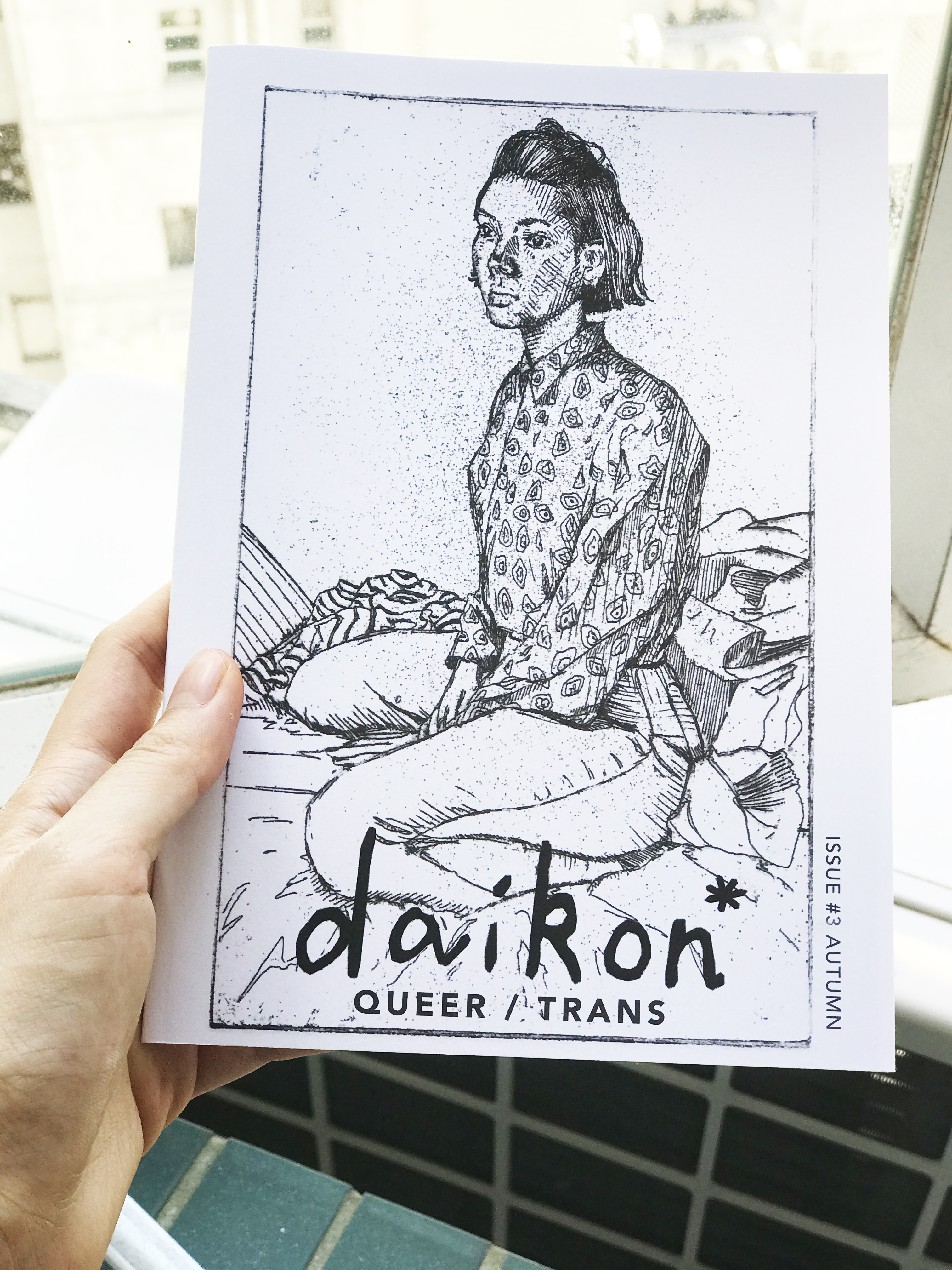
daikon Issue 3: Queer/Trans (from QRL’s zine collection)
Not having a physical location for QRL is both limiting and freeing. While we have the freedom to show-up in whatever space will have us, we also recognize that not having a space is due to the limitation of resources for many grassroots collections like ours. At the end of the day though, we always say that it’s not about the books themselves but the connections we make. What gives QRL it’s power is the relationships we build with our readers, fellow artists, and other queer folks worldwide.
QZF: When we were planning for the 2020 fest (which couldn’t happen because of COVID), we definitely were thinking about how to present the full spectrum of Queer zinesters here while also being mindful of younger or more cautious attendees. Like, how do you present BDSM zines but still be respectful of those who don’t want to see this kind of content? Do you need to curate your festival accordingly, or do you leave it up to visitor discretion? This is a point of tension we’re still calibrating, and it's exciting to be working these kinks out together.
We’ve toyed around with unarchiving queer chapbooks in Singapore’s history, but research is a little bit out of our grasp right now as we’re focusing our energies on the present community. We’re curious to see if the eventual mode of documenting ephemera will be centered on digitisation or preservation. At this point, we’re just collectors with our own little zine economy of print matter and ideas.
QRL: We are most grateful for how these conversations and alliances help build solidarity around our shared joys and struggles, helping us imagine ourselves beyond borders and nationalities. Whether it’s about production notes on how to bind zines to exchanging new bodies of work about queerness, our conversations with other artists and collectives are the basis from which QRL draws its strength, pleasure and meaning. There’s an infinite power to seeing each other for how we want to be seen, and the publications and conversations around the library can facilitate a special kind of bond. As the pandemic has now created circumstances where being indoors is vital, we are hopeful that digital face-time and direct messaging can continue nourishing the bonds we’ve built face-to-face, and others we haven’t yet but are excited to forge. It helps us rest easier at night knowing that there are others in their bedrooms somewhere, making, building, and dreaming alongside us.
QZF: It's all thrilling so it's really hard to pinpoint a single thing about this that we're most jazzed for. But maybe the most immediately exciting thing is the possibility of a better-connected Queer Asia beyond the larger LGBTQIA+ institutions and organisations that currently have the mobility to cross geographical borders and start conversations. It's really exciting to think about what this might mean for younger or less mobile Queer people - to be able to connect to a much wider Queer community and access resources and support that might not be so readily available locally.
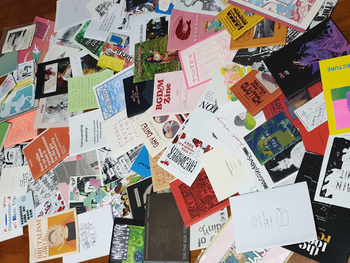
worms' (QZF) zine collection
![]()
Joy’s (QZF) zine collection
Queer Zinefest SG (QZF) is Singapore's first LGBTQIA+ zine festival. It was first held on July 14th, 2018, as a celebration of zine-making, queer art, and queer people. QZF also runs satellite events, zine workshops and hosts a Queer SG Discord channel.
Queer Reads Library (QRL) is a mobile collection of books and independently published zines centred around queer narratives and themes. Catalyzed by the removal of ten LGBTQ-themed children’s books from public shelves by the Hong Kong Public Library in June 2018, QRL was created in Fall 2018 to cultivate a space where queer people can gather and celebrate their narratives. In the beginning, we asked ourselves: “Where is the queer community in Hong Kong?”
QRL, much like queer gender and sexuality, is fuelled by the fluid, experimental, and (sometimes) mischievous. We are interested in where our library will take us and who wants to engage with queer histories and narratives, specifically through printed matter.
QRL aims to connect and collaborate with queer Asian people in the continent and in the diaspora. By virtue of our connections, our team spans across two continents. Currently, artist-publisher Beatrix Pang and artist-curator Kaitlin Chan are based in Hong Kong, while artist-writer Rachel Lau is based in Vancouver.
We’ve toyed around with unarchiving queer chapbooks in Singapore’s history, but research is a little bit out of our grasp right now as we’re focusing our energies on the present community. We’re curious to see if the eventual mode of documenting ephemera will be centered on digitisation or preservation. At this point, we’re just collectors with our own little zine economy of print matter and ideas.
OLS: This interview, in some ways, speaks to the very heart of both Queer Reads Library and Queer Zine Fest in that it is collaborative in nature and reaches across geographical boundaries. Tell us about what excites your teams most when it comes to the possibilities that these relationships open up, particularly around decentralising, organising and reimagining friendships, alliances and coalitions.
QRL: We are most grateful for how these conversations and alliances help build solidarity around our shared joys and struggles, helping us imagine ourselves beyond borders and nationalities. Whether it’s about production notes on how to bind zines to exchanging new bodies of work about queerness, our conversations with other artists and collectives are the basis from which QRL draws its strength, pleasure and meaning. There’s an infinite power to seeing each other for how we want to be seen, and the publications and conversations around the library can facilitate a special kind of bond. As the pandemic has now created circumstances where being indoors is vital, we are hopeful that digital face-time and direct messaging can continue nourishing the bonds we’ve built face-to-face, and others we haven’t yet but are excited to forge. It helps us rest easier at night knowing that there are others in their bedrooms somewhere, making, building, and dreaming alongside us.
QZF: It's all thrilling so it's really hard to pinpoint a single thing about this that we're most jazzed for. But maybe the most immediately exciting thing is the possibility of a better-connected Queer Asia beyond the larger LGBTQIA+ institutions and organisations that currently have the mobility to cross geographical borders and start conversations. It's really exciting to think about what this might mean for younger or less mobile Queer people - to be able to connect to a much wider Queer community and access resources and support that might not be so readily available locally.

worms' (QZF) zine collection
Joy’s (QZF) zine collection
Queer Zinefest SG (QZF) is Singapore's first LGBTQIA+ zine festival. It was first held on July 14th, 2018, as a celebration of zine-making, queer art, and queer people. QZF also runs satellite events, zine workshops and hosts a Queer SG Discord channel.
Queer Reads Library (QRL) is a mobile collection of books and independently published zines centred around queer narratives and themes. Catalyzed by the removal of ten LGBTQ-themed children’s books from public shelves by the Hong Kong Public Library in June 2018, QRL was created in Fall 2018 to cultivate a space where queer people can gather and celebrate their narratives. In the beginning, we asked ourselves: “Where is the queer community in Hong Kong?”
QRL, much like queer gender and sexuality, is fuelled by the fluid, experimental, and (sometimes) mischievous. We are interested in where our library will take us and who wants to engage with queer histories and narratives, specifically through printed matter.
QRL aims to connect and collaborate with queer Asian people in the continent and in the diaspora. By virtue of our connections, our team spans across two continents. Currently, artist-publisher Beatrix Pang and artist-curator Kaitlin Chan are based in Hong Kong, while artist-writer Rachel Lau is based in Vancouver.
© Singapore Art Book Fair 2025. All rights reserved.
For further enquiries, please contact us at info@singaporeartbookfair.org.
Singapore Art Book Fair is organised by
![]()
For further enquiries, please contact us at info@singaporeartbookfair.org.
Singapore Art Book Fair is organised by
